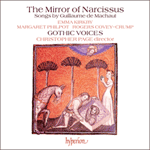The beautiful rondeau
Rose, lis, printemps, verdure (Rondeau 10) seems to have circulated after Machaut’s death, though no copies of the song itself survive in manuscripts other than the ‘central’ Machaut collected works sources. However, an anonymous rondeau found in two northern Italian sources from around 1400,
Rose sans per (‘Rose without equal’), quotes the opening of Machaut’s rondeau, clearly inspired by the shared metaphor of the rose representing the lady. The composer of this anonymous song also drew upon one of the most striking musical features of
Rose, lis, printemps, verdure: the alternation between two metrical patterns, a procedure known as hemiola, that gives the song its beautiful lilting quality. This rhythmic play was innovative at the time
Rose, lis, printemps, verdure was composed (by 1350), and the anonymous composer of
Rose sans per seems to have drawn on this innovation, and expanded upon it, in his own song, which combines not two but three different metres.
from notes by Anne Stone © 2015
Source «centrale», les œuvres complètes de Machaut sont les seules à conserver une trace manuscrite du magnifique rondeau
Rose, lis, printemps, verdure (rondeau 10), qui paraît toutefois avoir également circulé après la mort du compositeur.
Rose sans per («Rose sans pareille»), un rondeau anonyme présent dans deux sources d’Italie du Nord datées de 1400 environ, en cite ainsi l’ouverture, manifestement inspiré, lui aussi, par la métaphore de la rose incarnant la dame. Son auteur s’appuya en outre sur l’une des caractéristiques musicales les plus saisissantes de
Rose, lis, printemps, verdure: l’alternance entre deux schémas métriques, un procédé appelé hémiole et qui confère à l’œuvre sa splendide qualité chantante. Il semble s’être inspiré de ce jeu rythmique, novateur au temps de
Rose, lis, printemps, verdure (1350), et l’avoir développé dans sa propre chanson, qui combine non pas deux mais trois mètres différents.
extrait des notes rédigées par Anne Stone © 2015
Français: Hypérion
Das wunderschöne Rondeau
Rose, lis, printemps, verdure (Rondeau 10) scheint ebenfalls nach Machauts Tod im Umlauf gewesen zu sein, obwohl Kopien des Liedes selbst nur in den „zentralen“ Werksammlungen Machauts überliefert sind. Ein anonymes Rondeau taucht allerdings in zwei norditalienischen Quellen von etwa 1400 auf,
Rose sans per („Rose ohne ihresgleichen“), wo der Beginn des Rondeaus von Machauts zitiert und das offensichtlich von der Metapher der Rose, die die Dame repräsentiert, inspiriert ist. Der Komponist dieses anonymen Liedes machte zudem Gebrauch von den auffallendsten musikalischen Charakteristika von
Rose, lis, printemps, verdure—das Alternieren zwischen zwei metrischen Mustern, eine sogenannte Hemiole, die dem Lied sein wunderschönes Wiegen verleiht. Dieses rhythmische Spiel war innovativ, als
Rose, lis, printemps, verdure um 1350 herum entstand, und der anonyme Komponist von
Rose sans per scheint sich auf diese Innovation bezogen und sie in seinem Lied noch etwas erweitert zu haben, da hier nicht nur zwei, sondern drei verschiedene Metren zum Zug kommen.
aus dem Begleittext von Anne Stone © 2015
Deutsch: Viola Scheffel


 RECORDING
RECORDING PERFORMANCE
PERFORMANCE

 Machaut: The Mirror of Narcissus
Machaut: The Mirror of Narcissus
